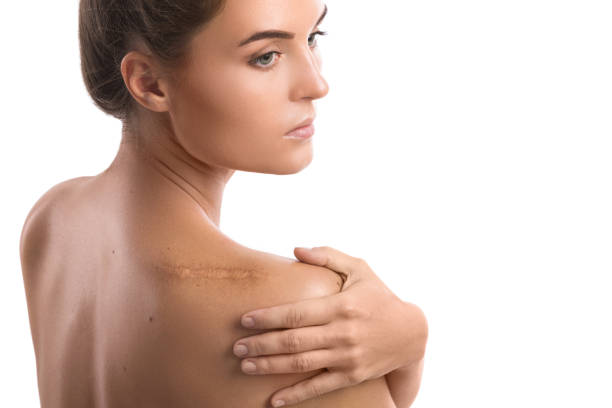
Woman with a scar on her shoulder over white background

What are Keloids?
Keloids are raised, thickened areas of skin that form due to an overgrowth of scar tissue. Unlike normal scars, Keloids can grow beyond the original wound and may continue to expand over time, causing discomfort or cosmetic concerns.
Types of Keloids
There are generally two types
- Spontaneous Keloids: These Keloids form without any obvious injury and can appear on the chest, shoulders, or back.
- Traumatic Keloids: These occur due to injuries such as burns, cuts, surgical scars, or even piercings.
Causes
Keloid form when the skin’s healing process is overactive, producing too much collagen. Common causes include:
- Surgical incisions.
- Skin trauma like cuts or burns.
- Acne scars or piercings.
- Inflammatory skin conditions like chickenpox or insect bites.
Signs and Symptoms
- Raised, thick skin: Keloids often rise above the skin and can feel hard or rubbery.
- Itching or tenderness: They may cause discomfort, itching, or even pain.
- Enlarged scar: Unlike normal scars, Keloid extend beyond the initial wound site.
- Color change: Keloid can appear red, pink, or darker than the surrounding skin.
Risk Factors
- Genetics: A family history of Keloid increases the likelihood of developing them.
- Skin tone: People with darker skin tones are more prone to Keloid.
- Age: Keloids are more common in individuals aged 10 to 30.
- Type of injury: Certain injuries, like burns or deep cuts, have a higher chance of forming Keloid.
How to Prevent
Preventing Keloids may not always be possible, but certain measures can reduce the risk:
- Proper wound care: Keeping the area clean and moist helps prevent scar overgrowth.
- Silicone gel sheets: Applying silicone sheets over the wound can reduce scar tissue formation.
- Avoid piercings or tattoos: If you’re prone to Keloid, avoid unnecessary skin trauma.
How to Manage Keloids
Managing Keloids involves reducing their appearance and preventing discomfort. This can be done through:
- Compression bandages: Wearing pressure garments can limit the growth of Keloid.
- Topical treatments: Using corticosteroid creams or silicone-based gels can help manage the size of Keloid.
How to Treat
- Steroid injections: These can help shrink the Keloid and reduce inflammation.
- Laser therapy: This helps flatten the Keloid and improves the skin’s appearance.
- Cryotherapy: Freezing the Keloid with liquid nitrogen can reduce its size.
- Surgical removal: In some cases, the Keloid may be surgically removed, but this carries the risk of the Keloid returnin
- Home Remedies for Keloids
- Aloe vera gel: Applying aloe vera can help reduce irritation and soften the skin.
- Tea tree oil: Known for its anti-inflammatory properties, tea tree oil can be applied to reduce itching and discomfort.
Medicine Brand Name and Price
- Mederma Gel: Price varies around ₹500-₹700 for a 20g tube.
- Contractubex Gel: Priced around ₹400-₹600 for a 20g tube.
- Silicone Gel Sheets: Cost ranges between ₹800-₹1500 depending on the brand.
Ayurvedic Medicines to Cure
- Kumkumadi Oil: Helps reduce scars and improves skin texture.
- Manjistha: An herbal remedy known for its anti-inflammatory and skin-healing properties.
- Aloe Vera: Used for soothing and reducing the appearance of scars.
Precautions
- Avoid direct sunlight on the Keloid to prevent darkening.
- Refrain from picking or scratching the area, as it can aggravate the condition.
- Seek medical advice before opting for any treatment, especially surgical
Self-Care Tips
- Apply moisturizing lotions regularly to keep the skin soft.
- Use sunblock with high SPF to protect the Keloid from UV exposure.
- Wear loose clothing to avoid friction over the affected area.
Conclusion
Keloids, though harmless, can cause cosmetic concerns and discomfort. With the right treatment plan, Keloid can be managed effectively. Whether opting for medical procedures, home remedies, or Ayurvedic treatments, it is crucial to consult a healthcare provider for personalized advice.
Disclaimer
This post provides general information about Keloids and is not intended to replace professional medical advice. Always consult a healthcare professional for accurate diagnosis and treatment of Keloid.
Additional Tips
- Keeping wounds clean and covered helps prevent Keloid formation.
- Regularly applying natural oils, like coconut or almond oil, may keep the skin hydrated and promote healing.
- Early treatment of Keloids can improve outcomes, so seek medical attention at the first sign of excessive scarring.
other link –https://www.cancer.gov/publications/dictionaries/cancer-terms/def/surgery






